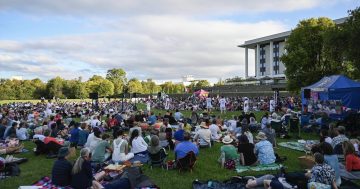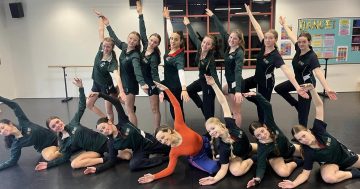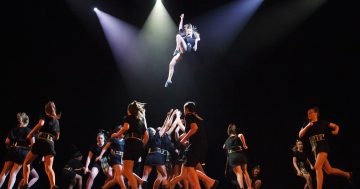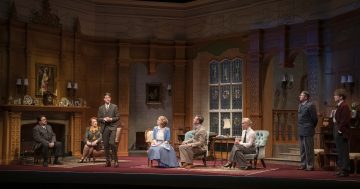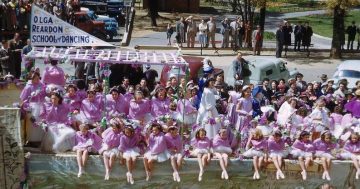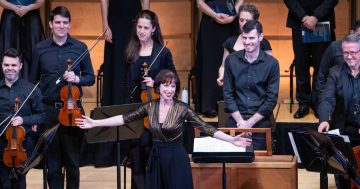
“The best way to understand and appreciate a Shakespeare play is to perform it.” With this philosophy in mind, Bell Shakespeare invited schools across Canberra to participate in its inaugural Schools Festival. Rather than just studying Macbeth in the classroom, the selected schools were challenged to perform it at The Playhouse at the Canberra Theatre Centre. With the play sliced into thirds the audience at the opening night were introduced to interpretations devised by students from St Edmund’s College, Canberra Grammar School and the Wanniassa School Enrichment Program (including students from Wanniassa, Namadgi and Calwell).
The performance was mainly for the benefit of the students – like a school play, the audience was mainly made up of friends and family. But the interpretations were interesting and the work the students had put in was obvious. Each of the schools had something to offer and by having played Macbeth at the Canberra Theatre Centre each of the students involved (whether cast or creative team or crew) now has an ownership of the play that can only be found through staging it – and on the same stage as Bell Shakespeare, no less.
The Wanniassa School Enrichment Program opened the night by taking us back in time to colonial Australia, imagining Duncan (Samantha Knight) and his troops as members of the colonial forces. Duncan holds court in his camp waiting for reports from the people who are actually doing the fighting for him, including the ambitious Macbeth (Lilly Schachentanz). After an encounter with some witches (found warming themselves around an oil drum in the bush) who corrupt the victorious general with promises of glory Macbeth and his feisty wife (Haidee Cavenagh) decide to claim the throne by murdering Duncan. What I liked about this segment was how it captured some of the subtleties in the play. Duncan is basically asking for it – he seems far too naive to be a competent King. And the Macbeths, far from bloodthirsty murderers, are amateurs learning on the job (no, Macbeth, don’t move the weapon from the murder scene, you’ll get blood everywhere). Less successful was the incorporation of an Indigenous perspective in the addition of two spirits to the background some scenes (The Lightning Brothers, a Wardaman Dreaming Story about balance the natural order). The idea was good – however it was under-used, if was going to be included it needed to be more of a part of the play. Haidee Cavenagh in particular gave an excellent performance and I hope she intends to continue developing her talent.
Canberra Grammar School was up next (taking us from the morning after the murder to the banquet). Their segment was the best of the night, a highly polished and very physical piece of theatre that used minimal elements to create scenes (a sheet of cloth and wooden staves were used very creatively). Their almost all-male production imagined the three witches (Jack Gaetjens, Tom Iverach, Josh Murray) as prisoners slain by Macbeth (now played by Ojas Jyoti). Reborn as vengeful ghosts, they moved through scenes invisibly manipulating events. This was a very clever idea and the execution was highly effective. Josh Hammond was also notable for providing some welcome comic relief as the tipsy Porter. If the school decides to develop their version of the entire play, put me down for a ticket.
The final segment (and perhaps the most interesting) came from St. Edmund’s college. This all-male production went Mad Max and had a post-apocalyptic setting, a perfect fit with how Macbeth’s world falls apart. Rather than having actors playing female characters, it was posited that due to a scarcity of women in the wasteland men take on female titles like mother when they have a wifely role. One of the best moments of the night was seeing Neil Mathieson’s Macduff fall to his knees and weep because his gay partner (Griffin Davies as Lady Macduff) and child had just been killed. While it was an interesting interpretation, part of me wished that the actors would just suck it up and play female roles – apparently there’s less stigma in pretending to be someone’s bitch than in pretending to be a woman.
As I’ve said, it was mainly an experience for the students, but there was enough engaging material to entertain the audience as well (not just parents and friends). At minimum, the participants in this performance (many of them non-actors) will have an amazing memory to look back on – and by being involved in creating a “real” piece of theatre (rather than just a school play) will now have greater identification with the theatre itself. With audiences ageing and dwindling it’s more important than ever to get younger people involved, and what better way then getting them up on stage? I think this is an interesting and important program: it’s teaching these students not just about theatre, but that their understanding of themselves and what they can do is a bit bigger than they might have imagined. I hope the program gets a second year so more students can have that opportunity.












